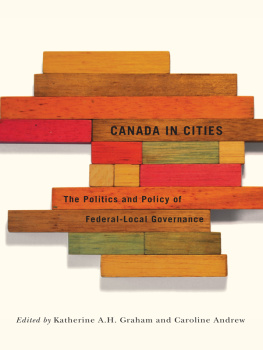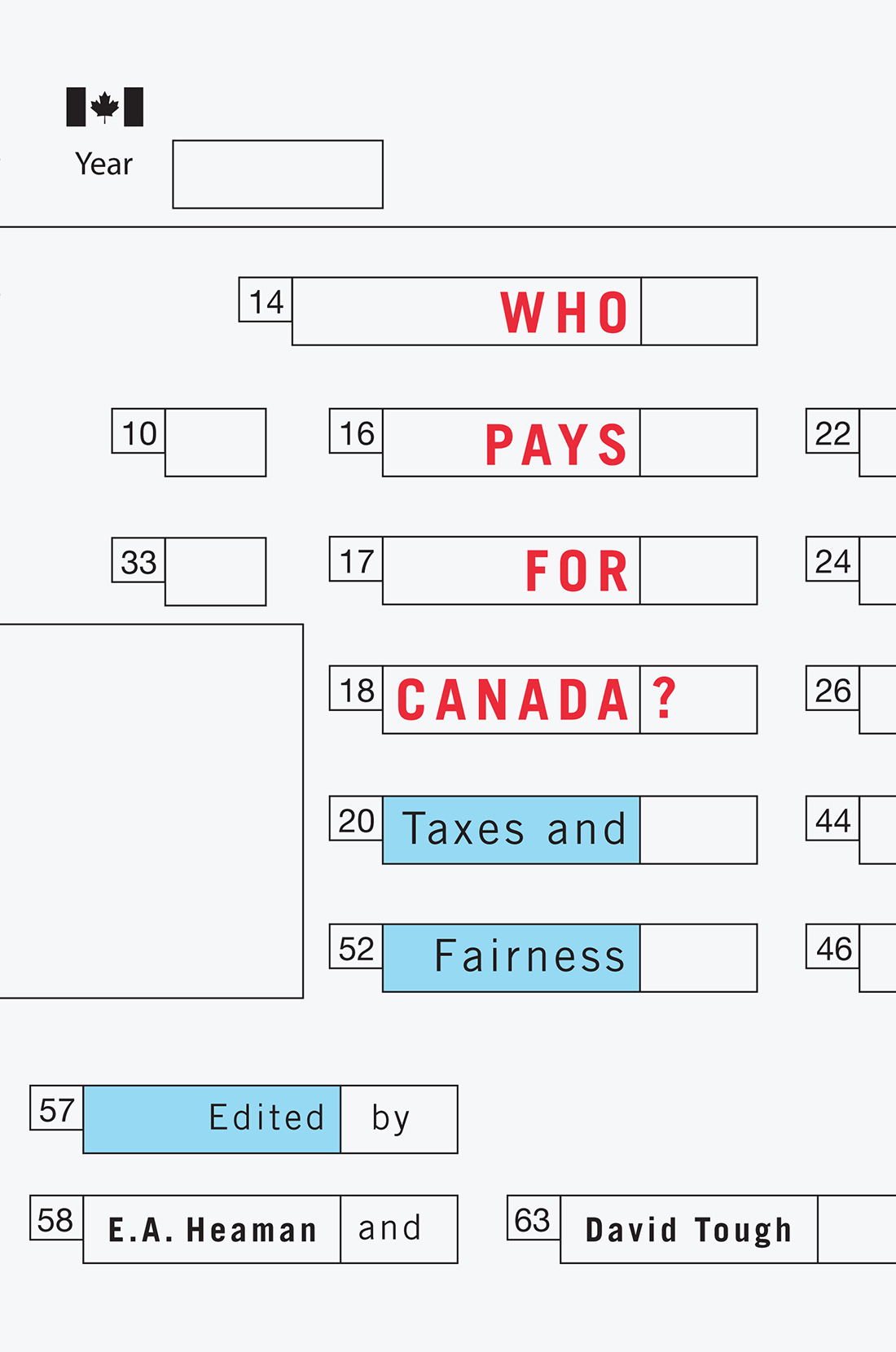WHO PAYS FOR CANADA?
Who Pays for Canada?
Taxes and Fairness
Edited by
E.A. HEAMAN AND DAVID TOUGH
McGill-Queens University Press
Montreal & Kingston London Chicago
McGill-Queens University Press 2020
ISBN 978-0-2280-0123-2 (cloth)
ISBN 978-0-2280-0124-9 (paper)
ISBN 978-0-2280-0259-8 (e PDF )
ISBN 978-0-2280-0260-4 (e PUB )
Legal deposit third quarter 2020
Bibliothque nationale du Qubec
Printed in Canada on acid-free paper that is 100% ancient forest free (100% post-consumer recycled), processed chlorine free
This book has been published with the help of grants from the McGill Institute for the Study of Canada and the Symons Trust Fund for Canadian Studies of Trent University.
We acknowledge the support of the Canada Council for the Arts.
Nous remercions le Conseil des arts du Canada de son soutien.
Library and Archives Canada Cataloguing in Publication
Title: Who pays for Canada?: taxes and fairness / edited by E.A. Heaman and David Tough.
Names: Heaman, E. A. (Elsbeth A.), 1964 editor. | Tough, David, 1971 editor.
Description: Includes bibliographical references and index.
Identifiers: Canadiana (print) 20200234269 | Canadiana (e BOOK ) 20200234277 | ISBN 9780228001232 (hardcover) | ISBN 9780228001249 (softcover) | ISBN 9780228002598 ( PDF ) | ISBN 9780228002604 (e PUB )
Subjects: LCSH : TaxationCanada. | LCSH : Fiscal policyCanada.
Classification: LCC HJ 2449 . W 46 2020 | DDC 336.200971dc23
This book was typeset by Marquis Interscript.
Contents
Tables and Figures
TABLES
1.1 Arguments about the institutional causes of tax policy distinctiveness 58
9.1 Income taxes payable by an unattached individual, Canada, US, and recommended rate, reproduced from the Carter Report 209
9.2 Income taxes payable by a family with two children, Canada, US, and recommended rate, reproduced from the Carter Report 210
10.1 Tax expenditure costs (mil) and proportion of benefits going to men (2018) 2267
11.1 Human development, gender, and tax ratio indicators, selected countries, 1995 to 2015 251
11.2 Revenue holes created by 19972005 and 20052016 federal income tax and GST cuts, 2016 254
11.3 Distribution of $52.3 billion in cumulative 19972016 personal income tax cuts, by decile and gender, 2016 256
11.4 Allocation of selected personal income tax expenditure items, by gender, 2013 259
11.5 Tax/transfer expenditures supporting womens unpaid vs paid work, Canada, 2018 264
11.6 Total tax paid plus childcare costs as percentage of full-time earned income for second-parent and single-parent earners, selected OECD countries, 2015 266
11.7 Change in after-tax income with Netherlands federal income tax rates, Canada, by gender and decile, 2016 270
11.8 Change in after-tax incomes of individualization of all tax/ transfer provisions, Canada, by gender and decile, 2016 272
13.1 Average scores for the different knowledge sections 305
14.1 Usage of tax fairness in Canadian federal budgets, 20092018 321
14.2 Important comparisons in the tax context 325
14.3 Framework for Canadian taxpayers perceptions of tax fairness 329
15.1 How the top 1 percent of St Johns fared compared with the other 25 metropolitan areas in Canada 349
15.2 Changes in the net worth of Newfoundlanders by quintile, constant 2012 dollars 350
FIGURES
1.1 Tax revenues as percentage of GDP , OECD countries, 2015 41
1.2 Tax progressivity, OECD countries, 2005 42
1.3 An inverse correlation between tax progressivity and total revenues 43
1.4 Proportion of each type of taxes as a share of the total tax burden, 2015 44
1.5 Pensions and unemployment benefits depend on social security contributions 45
1.6 Taxes on goods and services, percentage of GDP , OECD countries, 2015 47
1.7 Property taxes, percentage of GDP , OECD countries, 2015 48
1.8 Ratio of capital taxes to labour taxes, 2012 49
1.9 Interprovincial differences in tax revenues, 2016 50
7.1 Corporate income tax rates and revenues in OECD countries, 19812016 174
7.2 US top incomes and Canadian top income shares 176
8.1 Share of own-source revenue raised by source and level of government, 1998 vs 2016 190
8.2 Share of own-source revenues by municipal governments by province, 2016 191
9.1 Taxes paid by married couple with two dependent children, one earner, in Canadian dollars, 1966: UK, Canada, US, and Carter Commission recommended rate 207
9.2 The Carter Commissions recommended rate schedules 211
10.1 Top five large tax expenditures for women (2018) 228
10.2 Top five large tax expenditures for men (2018) 231
10.3 RRSP gender impact disaggregated (2018) 232
10.4 Federal transfers benefit by gender (2018) 235
10.5 Total tax expenditures compared to total transfers (2018) 237
11.1 Personal, corporate, social contribution, and consumption tax revenue as percentage of total revenue in low-, medium-, and high-income countries, 1990 244
11.2 Personal, corporate, social contribution, and consumption tax revenue as percentage of total revenue in low-, medium-, and high-income countries, 2014 245
11.3 Average market income, by gender and age (estimated) Canada, 2016 255
13.1 In your opinion, which of these income sources are taxable or non-taxable? 303
13.2 Based on the following list of products and services, state whether the Quebec sales tax ( QST ), the goods and services tax ( GST ), or both taxes are applicable 304
13.3 When you contribute $1,000 to a registered retirement savings plan, the tax refund that you get is about the same regardless of your level of income 304
13.4 Weighted effects of personal characteristics on global score 308
13.5 Objective classification 312
13.6 Subjective classification 312
13.7 Self-assessment errors 313
13.8 Opinion on tax burden of high-income earners 314
15.1 Net profits compared to wages and salaries 339
15.2 The evolution in provincial revenues, 20002017 340
15.3 Rapidly changing fortunes: people and income in 2007 and 2015 compared 342
15.4 Basking in the sunshine: provincial income tax as a proportion of total income 343
15.5 Contrasting experiences of poverty for women in Newfoundland and Canada, 200415 351
FOREWORD
Tax Transparency and Perceptions
of Fairness:
What It Means, How to Get It,
and Why It Matters
Kevin Page
In his Prison Notebooks , written in the 1920s, Antonio Gramsci said presciently, The crisis consists precisely in the fact that the old is dying and the new cannot be born. In this interregnum a great variety of morbid symptoms appear. I share this feeling that from many perspectives geopolitical, environmental, social, and economic the world is stuck in a gap between paradigms. The morbid symptoms play out on the nightly news Brexit and the possible weakening of the European project; severe storms that reminds us that we do not have infrastructure to deal with climate change; suicides by young indigenous people or veterans dealing with PTSD ; a US economy turning inwards with an America First trade strategy.
Hebrew University history professor and popular author Yuval Noah Harari raises a number of questions in his 2015 book, Homo Deus: A Brief History of Tomorrow , that policymakers of all types must grapple with in this century: What will happen to the job market once artificial intelligence outperforms humans in most cognitive tasks? What will be the political impact of a massive new class of economically less useful people? What will happen to relationships, families and pension funds when nanotechnology and regenerative medicine turn eighty into the new fifty? What will happen to human society when biotechnology enables us to have designer babies, and to open unprecedented gaps between the rich and poor? We do not know the future. As Maynard Keynes said: the future is not uncertain, it is unknowable. What if Professor Harari has it right? What if he is even half right? What are the implications for effective public policy including tax policy and the principles, institutions, and processes that must support it?











